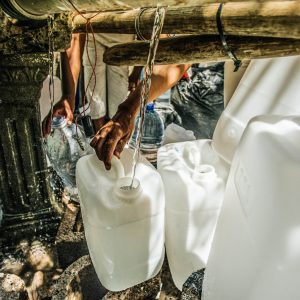U.S. Year-In-Review, 2018
Regulators, politicians forced to confront the consequences of environmental change.
By Brett Walton
Circle of Blue – December 20, 2018
What was water in the United States this year? For one, it was visible — and vividly so.
Red tides of algae and dead turtles on Florida’s coasts. Ashen skies and drained reservoirs in the western states, where fires and aridity reigned. Foaming rivers and lakes in Michigan, a consequence of PFAS chemicals stirred to a froth.
Water overwhelmed natural barriers in North Carolina, where the Cape Fear region turned into an inland sea in September after Hurricane Florence disgorged nearly 3 feet of rain.
Such dramatic environmental change is not entirely new. Algal blooms and dead zones have plagued the Gulf of Mexico for years, and Lake Mead, the big Colorado River reservoir that is a linchpin for water supplies in the Southwest, is amid a two-decade-long plunge. Environmental stories, as the saying goes, don’t break — they ooze.
But the magnitude and severity of the changes today — larger, wetter, drier than before — is new. Growing, too, is the number of people in harm’s way. The combination — the rumblings of a dyspeptic planet and people living in vulnerable areas — have forced regulators and politicians to take notice.
“Water security in the United States is increasingly in jeopardy,” wrote the authors of the federal government’s National Climate Assessment, released in November.
Notice is one step. Action is another, of course. Some — hardly all — authorities are appraising risks and responding accordingly. Much of the challenge involves cleaning up messes of society’s own making.
On the drinking water front, states, utilities, and the federal government are grappling with how best to address man-made PFAS chemicals. Congress took small steps this year — funding a health study of veterans exposed to the chemicals on military bases, and allowing commercial airports to use PFAS-free firefighting foams, a main contamination source — but elsewhere federal action is lagging.
The U.S. Environmental Protection Agency seems likely to regulate at least two PFAS chemicals in drinking water. But a final standard will take years to develop, agency officials say, and there are more than 4,000 such substances in use. In the meantime, states are setting their own standards, and dozens of utilities are suing 3M and other manufacturers to recover costs of water treatment and environmental cleanup. As with lead rules, the states are taking charge.
In the Colorado River basin, seven states are working on a drought plan to prop up a shrinking Lake Mead and eventually reduce their use of the drying river. In California, state regulators approved a plan in December to keep more water in the San Joaquin River and its tributaries, for salmon habitat predominantly but also for the benefits of downstream cities and farms. A controversial proposal to build a pair of tunnels to move water around the Sacramento-San Joaquin delta will not be completed before Gov. Jerry Brown, its most significant backer, leaves office the first week of January.
These are big, contentious issues. They are expensive to address and involve negotiations between competing uses. Many will face court challenges.
These cases illustrate one of the primary tensions in 2018: the interaction between local, state, and federal authorities.
The Trump administration, nearing the halfway mark of its first term, favors cutting federal oversight as much as possible: from coal ash ponds and power plant discharges to, most recently, the scope of the Clean Water Act.
In December, the EPA and Army Corps proposed a significantly narrower definition of which waterways have federal protection. Within state agencies, the country’s pipeline boom led to tussles over Clean Water Act permitting that New York had used to reject an unwanted natural gas conduit. Bills in Congress to revoke state authority did not go anywhere.
In some cases, courts will have the final word. The DC Circuit, for example, ruled in August that the EPA’s coal ash rules, written by the Obama administration, were not strong enough to protect groundwater and surface waters from pollution. The court ordered the agency back to the drawing board. The U.S. Supreme Court is now considering cases that question whether the EPA has authority to regulate pollution that enters rivers and lakes via groundwater.
A number of other unresolved actions will spill over into 2019. The Bureau of Reclamation, its patience with state negotiations at an end, gave the Colorado River basin a January 31 deadline to finalize drought plans. Five states have completed the task, and California is nearly there. The question mark is Arizona, whose plan needs to be approved by state lawmakers. The Legislature convenes January 14.
The EPA will advocate for its Clean Water Act rollback. A 60-day public comment period will open soon, and the agency plans one public meeting – in Kansas City, Kansas, on January 23 – to discuss the proposal.
The EPA also expects to publish its draft revisions to the Lead and Copper Rule in February. And in the spring the agency should release draft drinking water standards for perchlorate, the first new contaminant to be regulated in more than two decades.
Speaking of Water – Looking back at 2018, ahead to 2019
Brett writes about agriculture, energy, infrastructure, and the politics and economics of water in the United States. He also writes the Federal Water Tap, Circle of Blue’s weekly digest of U.S. government water news. He is the winner of two Society of Environmental Journalists reporting awards, one of the top honors in American environmental journalism: first place for explanatory reporting for a series on septic system pollution in the United States(2016) and third place for beat reporting in a small market (2014). He received the Sierra Club’s Distinguished Service Award in 2018. Brett lives in Seattle, where he hikes the mountains and bakes pies. Contact Brett Walton
Related
© 2025 Circle of Blue – all rights reserved
Terms of Service | Privacy Policy





